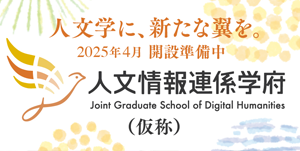第5回 広人文学コース シンポジウムのご案内
記事投稿日:2016.12.05
その他
5th IMAP in Japanese Humanities Symposium on Pre-Modern Japanese Culture
December 19, 2016
Kyushu University, Faculty of Humanities
Humanities Building, 4th floor, Conference Room
The following guests are funded by Kyushu University's World Premier International Researcher Invitation Program ("Progress 100"):
Ivo Smits, Professor of Arts & Cultures of Japan, Institute for Area Studies (LIAS), Leiden University
Torquil Duthie, Associate Professor, Department of Asian Languages and Cultures, University of California, Los Angeles
We are grateful for the participation of:
Kyushu University Tokutei Project visiting scholar Judith Rabinovitch, Karashima Tsukasa Professor Emerita of Japanese Language and Culture at the University of Montana
International Master's Program / International Doctorate in Japanese Humanities (IMAP/IDOC) in the Graduate School of Humanities at Kyushu University faculty organizers: Professors Cynthea J. Bogel and Ellen Van Goethem
December 19, 2016
11:00-12:30 Ivo Smits
"Lotus Meditation in a Boat: Renzen and the Landscape Outside the Capital in the 1140s"
Abstract
This presentation will center around the travel poetry of a fairly unknown but quite prolific late Heian kanshi 漢詩 poet, known as 'the monk Renzen' or 'Lotus Meditation' (Shaku Renzen 釈蓮禅, 1082?-?). Active in the first half of the twelfth century, he has been nicknamed 'the Saigyō of Sino-Japanese poetry' because of his extensive travels. His most substantial legacy is indeed a long sequence of kanshi (Sinitic verse) made on one or more journeys to northern Kyushu in the early 1140s.
I will use this sequence to illustrate a number of assumptions about Sino-Japanese poetic practice and networks in twelfth-century Japan. One such assumption is that composition in Sino-Japanese offered poets great thematic freedom, a point that is directly related to the two main templates of kanshi: 'topic poetry' (kudaishi) and its supposed antithesis, 'no-topic poetry' (mudaishi). Another assumption is a program of cultural codification of landscapes and their representations, which is related to a discernible creative interest in a world outside court society. Finally, a third assumption is that networks of poets could include poets who no longer discernably functioned within the usual parameters of the scholar-bureaucrat-poet.
12:30-1:00 Lunch break
1:00-2:30 Torquil Duthie
"Envisioning the Realm: Place-Naming and the Rhetoric of Land-Viewing in Early Japanese Texts"
Abstract
Kunimi is generally understood to be an ancient Japanese ritual in which the ruler climbed a mountain or high place and gazed down upon the land. However, the wide variety of references to land-viewing in extant texts of the Nara period do not really point to the existence of specific kunimi ritual but rather to a multi-faceted "land-viewing" motif that functioned primarily as a narrative and rhetorical trope. "Land-viewing" may have been a ritual practice in which the sovereign envisioned his or her realm, but the sovereign's visions depended on literary language--on poetry and narrative--to be described and recorded. In this paper I will discuss the significance of place-naming in the poetry of the Man'yōshū in relation to the rhetoric of land-viewing.
For further information, please contact cjbogel@lit.kyushu-u.ac.jp










